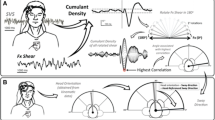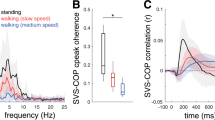Abstract
The relative contribution of vestibular and somatosensory information to triggering postural responses to external body displacements may depend on the task and on the availability of sensory information in each system. To separate the contribution of vestibular and neck mechanisms to the stabilization of upright stance from that of lower body somatosensory mechanisms, responses to displacements of the head alone were compared with responses to displacements of the head and body, in both healthy subjects and in patients with profound bilateral vestibular loss. Head displacements were induced by translating two 1-kg weights suspended on either side of the head at the level of the mastoid bone, and body displacements were induced translating the support surface. Head displacements resulted in maximum forward and backward head accelerations similar to those resulting from body displacements, but were not accompanied by significant center of body mass, ankle, knee, or hip motions. We tested the effect of disrupting somatosensory information from the legs on postural responses to head or body displacements by sway-referencing the support surface. The subjects' eyes were closed during all testing to eliminate the effects of vision. Results showed that head displacements alone can trigger medium latency (48–84 ms) responses in the same leg and trunk muscles as body displacements. Nevertheless, it is unlikely that vestibular signals alone normally trigger directionally specific postural responses to support surface translations in standing humans because: (1) initial head accelerations resulting from body and head displacements were in opposite directions, but were associated with activation of the same leg and trunk postural muscles; (2) muscle responses to displacements of the head alone were only one third of the amplitude of responses to body displacements with equivalent maximum head accelerations; and (3) patients with profound bilateral vestibular loss showed patterns and latencies of leg and trunk muscle responses to body displacements similar to those of healthy subjects. Altering somatosensory information, by sway-referencing the support surface, increased the amplitude of ankle muscle activation to head displacements and reduced the amplitude of ankle muscle activation to body displacements, suggesting context-specific reweighting of vestibular and somatosensory inputs for posture. In contrast to responses to body displacements, responses to direct head displacements appear to depend upon a vestibulospinal trigger, since trunk and leg muscle responses to head displacements were absent in patients who had lost vestibular function as adults. Patients who lost vestibular function as infants, however, had near normal trunk and leg response to head displacements, suggesting a substitution of upper trunk and neck somatosensory inputs for missing vestibular inputs during development.
Similar content being viewed by others
References
Abrahams VC, Falchetto S (1969) Hind leg ataxia of cervical origin and cervico-lumbar spinal interactions with a supratentorial pathway. J Physiol (Lond) 203:435–447
Allum J, Honegger F (1992) A postural model of balance-correcting movement strategies. J Vest Res 2:323–317
Allum J, Honegger F, Schicks H (1993) Vestibular and proprioceptive modulation of postural synergies in normal subjects. J Vest Res 3:59–85
Allum J, Honegger F, Schicks H (1994) The influence of a bilateral peripheral vestibular deficit on postural synergies. J Vest Res 4:49–70
Allum J, Pfaltz CR (1985) Visual and vestibular contributions to pitch sway stabilization in the ankle muscles of normals and patients with bilateral vestibular deficits. Exp Brain Res 58:82–94
Andersson O, Grillner S (1981) Peripheral control of the cat's step cycle. I. Phase dependent effects of ramp-movements of the hip during “fictive locomotion”. Acta Physiol Scand 113:89–101
Andersson O, Grillner S (1983) Peripheral control of the cat's step cycle. II. Entrainment of the central pattern generators for locomotion by sinusoidal hip movements during “fictive locomotion”. Acta Physiol Scand 117:229–239
Benson AJ, Brown SF (1992) Perception of liminal and supraliminal whole-body angular motion. In: Berthoz A, Graf W, Vidal PP (eds) The head-neck sensory-motor system. Oxford University Press, Oxford, pp 483–487
Benson AJ, Spencer MB, Stott J (1986) Thresholds for the detection of the direction of movement of whole-body, linear movement in the horizontal plane. Aviat Space Environ Med 57:1088–1096
Benson AJ, Hutt ECB, Brown SF (1989) Thresholds for the perception of whole-body angular movement about a vertical axis. Aviat Space Environ Med 60:205–213
Berthoz A, Pozzo T (1988) Intermittent head stabilization during postural and locomotor tasks in humans. In: Amblard B, Berthoz A, Clarac F (eds) Posture and gait: development, adaptation and modulation. Elsevier, Amsterdam, pp 189–198
Boyle R, Goldberg JM, Highstein SM (1992) Inputs from regularly and irregularly discharging vestibular-nerve afferents to secondary neurons in the vestibular nuclei of the squirrel monkey. III. Correlation with vestibulo-spinal and vestibulo-ocular output pathways. J Neurophysiol 68:471–484
Britton TC, Day BL, Brown P, Rothwell JC, Thompson PD, Marsden CD (1993) Postural electromyographic responses in the arm and leg following galvanic vestibular stimulation in man. Exp Brain Res 94:143–151
Brodal A (1974) Anatomy of the vestibular nculei and their connections. In: Kornhuber H (eds) Handbook of sensory physiology vol 6 (1) The vestibular system. Springer, Berlin Heidelberg New York, pp 239–252
Buford J, Smith J (1993) Adaptive control for backward quadrupedal walking: II. Hindlimb muscle synergies. J Neurophysiol 64:755–766
Cordo P, Nashner L (1982) Properties of postural adjustments associated with rapid arm movements. J Neurophysiol 47:287–302
Crowe TK, Horak FB (1988) Motor proficiency associated with vestibular deficits in children with hearing impairments. Phys Ther 68:1493–1499
DeJong TVM, DeJong JMBV, Cohen B, Jongkees LBW (1977) Ataxia and nystagmus induced by injection of local anesthetics in the neck. Ann Neurol 1:240–246
Diener HC, Dichgans J, Bruzek W, Selinka H (1982) Stabilization of human posture during induced oscillations of the body. Exp Brain Res 45:126–132
Diener HC, Dichgans J, Guschlbauer B, Mau H (1984) The significance of proprioception on postural stabilization as assessed by ischemia. Brain Res 296:103–109
Dietz V, Horstmann GA, Berger W (1988) Fast head tilt has only a minor effect on quick compensatory reactions during the regulation of stance and gait. Exp Brain Res 73:470–476
Fregly A (1974) Vestibular ataxia and its measurement in man. In: Kornhuber HH (eds) The vestibular system. Handbook of sensory physiology, vol 6. Springer, Berlin Heidelberg New York, pp 321–360
Gollhofer A, Horstmann G, Berger W, Dietz V (1989) Compensation of translational and rotational perturbations in human posture: stabilization of the center of gravity. Neurosci Lett 105:73–78
Greenwood R, Hopkins A (1976) Landing from an unexpected fall and a voluntary step. Brain 99:375–386
Hirschfeld H, Forssberg H (1994) Postural adjustments in sitting humans following external perturbations: Muscle activity and kinematics. Exp Brain Res 97:515–527
Horak FB (1992) Set and gain control of posture in cerebellar and vestibular patients. IEEE Trans Biomed Eng 11:95–96
Horak F, Nashner L (1986) Central programming of postural movements: adaptation to altered support surface configurations. J Neurophysiol 55:1369–1381
Horak F, Shumway-Cook A, Crowe T, Black FO (1988) Vestibular function and motor proficiency of children with impaired hearing or with learning disability and motor impairments. Dev Med Child Neurol 30:64–79
Horak F, Nashner L, Diener H (1990) Postural strategies associated with somatosensory and vestibular loss. Exp Brain Res 82:167–177
Horstmann G, Dietz V (1988) The contribution of vestibular input to the stabilization of human posture: a new experimental approach. Neurosci Lett 95:179–184
Inglis JT, Macpherson JM (1992) Postural responses following bilateral laryrinthectomy. In: Woollacott M, Horak FB (eds) Posture and gait: control mechanisms, vol 1. University of Oregon Press, Eugene OR, pp 268–271
Kaga K, Suzuki J, Marsh RR (1981) Influence of labyrinthine hypoactivity on gross motor development of infants. Ann NY Acad Sci 374:412–416
Keshner EA, Allum JHJ, Pfaltz CR (1987) Postural coactivation and adaptation in the sway stabilizing responses of normals and patients with bilateral vestibular deficit. Exp Brain Res 69:77–92
Keshner EA, Woollacott MH, Debu B (1988) Neck, trunk and limb muscle responses during postural perturbations in humans. Exp Brain Res 71:455–466
Koozekanani S, Stockwell C, McGhee P, Firzoomand F (1980) On the role of dynamic models in quantitative posturography. IEEE Trans Biomed Eng 27:605–609
Kuo A, Zajac F (1993) Human standing posture: multijoint movement strategies based on biomechanical constraints. Brain Res 97:349–358
Lacour M, Xerri C, Hugon M (1978) Muscle responses and monosynaptic reflexes in falling monkey: Role of the vestibular system. J Physiol (Paris) 74:427–438
Lee W (1984) Neuromotor synergies as a basis for coordinated action. J Motor Behav 16:135–170
Macpherson J (1991) How flexible are muscle synergies? In: Humphrey D, Freund JH (eds) Motor control: concepts and issues. Wiley, Chicester, pp 33–47
Marchand AR, Amblard B (1990) Early sensory determinants of locomotor speed in adults cats: I. Visual compensation after bilabyrinthectomy in cats and kittens. Behav Brain Res 37:215–225
McCollum G, Horak F, Nashner L (1984) Parsimony in neural calculations for postural movements. In: Bloedel J, Dichgans J, Precht W (eds) Cerebellar functions. Springer, Berlin Heidelberg New York, pp 54–66
Melvill-Jones G, Watt D (1971) Muscular control of landing from unexpected falls in man. J Physiol (Lond) 219:729–737
Nashner L (1971) A model describing vestibular detection of body sway motion. Acta Otolaryngol (Stockh) 72:429–436
Nashner L (1977) Fixed patterns of rapid postural responses among leg muscles during stance. Exp Brain Res 30:13–24
Nashner L (1982) Adaptation of human movement to altered environments. Trends Neurosci 5:358–361
Nashner L, Wolfson P (1974) Influence of head position and proprioceptive cues on short latency postural reflexes evoked by galvanic stimulation of the human labyrinth. Brain Res 67:255–286
Nashner L, McCollum G (1985) The organization of human postural movements: a formal basis and experimental synthesis. Behav Brain Sci 8:135–172
Nashner L, Woollacott M, Tuma G (1979) Organization of rapid responses to postural and locomotor-like perturbations of standing man. Exp Brain Res 36:463–475
Nashner L, Black FO, Wall C III (1982) Adaptation to altered support surface and visual conditions during stance: patients with vestibular deficits. J Neurosci 2:536–544
Nashner L, Shupert C, Horak F, Black FO (1990) Organization of sensory inputs to posture: a formal analysis based on sensory and mechanical constraints. Prog Brain Res 80:411–418
Shinoda Y, Ohgaki T, Futami T (1986) The morphology of single lateral vestibulospinal tract axons in the lower cervical spinal cord of the cat. J Comp Neurol 249:226–241
Shinoda Y, Ohgaki T, Sugiuchi Y, Futami T (1992) Morphology of single medial vestibulospinal tract axons in the upper cervical spinal cord of the cat. J Comp Neurol 316:151–172
Shupert C, Horak FB, Dietz V, Horstmann G (1990) Automatic responses to head/neck perturbations. In: Brandt T, Paulus W, Bles W, Dieterich M, Krafczyk S, Straube A (eds) Disorders of posture and gait. Thieme, Stuttgart, pp 177–180
Shupert C, Horak FB, Black FO (1992) Effect of peripheral vestibular disorders on head-trunk coordination during postural sway in humans. In: Berthoz A, Graf W, Vidal PP (eds) The head-neck sensory-motor system. Oxford University Press, New York, pp 607–610
Storper I, Honrubia V (1992) Is human galvanically induced triceps surae electromyogram a vestibulospinal reflex response? Otolaryngol Head Neck Surg 107:527–536
Watt D (1981) Effect of vertical linear acceleration on H-reflex in decerebrate cat: I. Transient stimuli. J Neurophysiol 45:644–666
Wilson VJ, Peterson BW (1981) Vestibulospinal and reticulospinal systems In: Brookhart JM, Mountcastle VB (eds) Handbook of physiology, section 1, vol 2 (1) The neurosystem. American Physiology Society, Bethesda, MD, pp 667–702
Winer BJ (1971) Statistical principles in experimental design, 2nd edn McGraw-Hill, New York
Xerri C, Borel L, Bathelemy J, Lacour M (1988) Synergistic interactions and functional working range of the visual and vestibular systems in postural control: neuronal correlates. Prog Brain Res 76:193–203
Author information
Authors and Affiliations
Rights and permissions
About this article
Cite this article
Horak, F.B., Shupert, C.L., Dietz, V. et al. Vestibular and somatosensory contributions to responses to head and body displacements in stance. Exp Brain Res 100, 93–106 (1994). https://doi.org/10.1007/BF00227282
Received:
Accepted:
Issue Date:
DOI: https://doi.org/10.1007/BF00227282




